
The Basics:
- For ages 6 and up
- For 1 to 4 players
- Approximately 20 minutes to complete
Geek Skills:
- Active Listening & Communication
- Counting & Math
- Risk vs. Reward
- Cooperative & Team Play
- Hand/Resource Management
Learning Curve:
- Child – Easy
- Adult – Easy
Theme & Narrative:
- Explore the dungeon with heroes who have absolutely no idea what they are doing, apparently…
Endorsements:
- Gamer Geek rejected!
- Parent Geek mixed!
- Child Geek approved!
Overview
American theoretical physicist, mathematician, and string theorist, Brian Greene, said “Exploring the unknown requires tolerating uncertainty.” In this game, you’ll be exploring a dungeon in the blind. What lies ahead of you is unknown and always random. You might encounter a monster or more treasure than you could possibly carry. Fame and glory are yours to be found, but so is a gory death. Being an unprepared hero is hard work!
Pocket Dungeon Quest, designed by Jeff Dehut and published by Breaking Games, is comprised of 121 tiles, one cloth game board, one cloth bag, and one custom six-sided die. The tiles are made of thick and durable cardboard, the game board is made of a thick and rough cloth material, and the cloth tile bag is velvety smooth, used for tile storage. Lots of quality in a little box!
Mapping the Dungeon
To set up the game, first find all the Hero and Heart tiles, setting them aside.
Second, place the game board in the middle of the playing area. Find the Dungeon tiles, place them face-down, randomize, and then place to the game board, keeping them face-down at all times to create a 10 x 10 grid.
Third, have each player select one of the Hero tiles and three Heart tiles, placing them in front of them. There is a space set aside for each player to place their tiles on the game board.
That’s it for game set up. Determine who will be the first player and begin your adventure!
Hero Basics and the Dungeon Economy
Heroes in Pocket Dungeon Quest are not generic but they are all equal in their ability to be heroic. Depending on the Hero tile selected, the player will have a special ability.
- The Warrior: Whenever the Warrior attacks, this brave fighter always adds one “Sword” to the die roll.
- The Archer: Whenever the Archer attacks, this lucky arrow slinger can re-roll the die once if they find their initial roll to be unfavorable.
- The Wizard: This crafty spell caster can use up to two “Spell” Item tiles per turn in their inventory.
- The Rogue: This sneaky individual can pick up (and use) one revealed item within their “Circle of Site” before attacking.
- The Adventurer: This well-seasoned hero knows their stuff. If the first revealed tile on the game board on their turn is a Trap or Monster, it’s discarded.
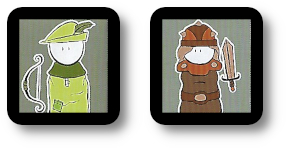
The opposite side of each hero is also the opposite sex
Each hero has an Inventory that can hold up to two Item tiles. If the player wants to collect a new Item tile, but already has two, they must discard one to the Merchant pile. All Item tiles sent to the Merchant pile are placed face-down…there is a reasons for this and we’ll get to it. The only exception to this rule are the Relics, which are never lost, are available to all players to use once found, and do not take up any space in the player’s inventory.
A player may use one Item in their inventory on their turn. Items include, but are not limited to, bombs, spells, and potions. Each has a unique effect. For example, the “Bomb” Item tile can be used to remove a Wall tile or as a successful hit in combat and the “Multi-tool” Item tile can be used to disarm a trap. Spells, once used, have special effects that sometimes require the die to determine the overall result. For example, the “Confusion Spell” Item tile causes two Monster tiles to fight each other, requiring the player to roll the die to see if they take each other down.
A player can decide to use their Item tile on another player or hand it to them (if that player has inventory space). This counts as “using the item”, which can only be done once per player’s turn.
All Item tiles in the Merchant pile can be purchased for 30 Gems each, but only after the Merchant tile has been revealed during the dungeon exploration (yes, you have to find the guy). After the Merchant has been found, once per turn, a player may decide to visit the merchant for a quick transaction. The Hero tile does not move from its current position, nor does it need to be near the Merchant tile (we think – the rules do not specify).
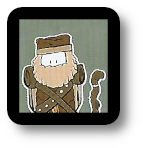
“Buy my stuff!”
If the player does have enough Gems to purchase an Item tile, they discard the Gem tiles to the Gem pile and then reveal two Item tiles in the Merchant pile, flipping them face-up. The player now selects one of the randomly revealed items as their own. The other Item tile returns to the Merchant.
An Adventuring We Will Go!
Pocket Dungeon Quest is played in turns with no set number of turns per game. A player’s turn is summarized here.
Step One: Move
The player can move their Hero tile to one other valid space on the game board in any direction (up, down, left, right, and diagonally). A “valid” space is any Floor tile or empty space on the grid. Wall tiles block movement.
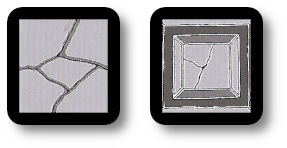
Floor to the left, Wall to the right
The one exception is the “Unicorn Pegasus” Item tile which acts as a mount. This special Item does not take up a slot in the hero inventory and allows the player to use any space with a Wall tile as a valid space to move into. Excelsior!

“Onward, brave steed!”
Step Two: Explore
A player’s Hero tile has a “Circle of Sight”, which are the eight tile spaces surrounding and adjacent to their Hero tile. Flip any tiles face-up that are in these spaces and only these tiles if any are still face-down. This will reveal what the Hero (from the Hero tile location) “sees”. Site and combat are not blocked by Wall tiles.
If the player revealed any Effect tiles, they are collected now and will be resolved this turn or as soon as possible. Effects do not stack or cancel each other, according to the rules, but they do (in the base game). Once they take effect, they are discarded. Not all effects are bad. While some will hamper the hero, some will improve their ability to kick butt.
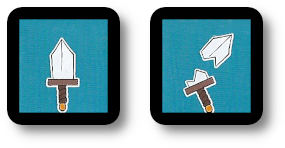
Ouch! I sat on my sword…
Step Three: Resolve Traps
Any Trap tiles revealed are now resolved. Each Trap tile deals one point of damage, forcing the player to discard one Heart token. If the player has the “Multi-tool” Item tile, they can disarm the trap, ensuring it does not cause damage. If the player is using the “Adventurer” Hero tile, they can disarm the Trap tile (for free), but only if it’s the first tile revealed during step two.
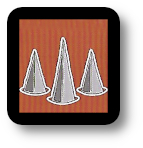
Disarmed and tripped Trap tiles are removed from the game board once resolved.
Step Four: Resolve Combat
All visible Monster tiles in the Hero tile’s “Circle of Site” are now engaged in combat, but one at a time and in the order in which the player wants to engage them. Combat is performed and resolved by rolling the six-sided die.
- Roll two or three “Swords”: the monster is hit and slayed! The Monster tile is removed and placed in the Monster pile.
- Roll one “Sword” or yellow “Bang”: the monster is hit, but gets a quick hit on the hero, as well. This results in the player discarding one Heart tile. The Monster tile is then removed and placed in the Monster pile.
- Roll “Red Skull”: a critical miss, resulting in the player discarding one Heart tile! The effects are different based on the monster. After damage and the effect is resolved, the Monster tile is removed (with one exception) and placed in the Monster pile.
- Goblin: The sneaky little creature forces the player to move one random Gem tile they had collected to the Gem pile.
- Flayers: The player loses their next turn.
- Slimes: The nasty ooze forces the player to move one random Item tile in their inventory to the Discard pile
- Minotaurs: The beast deals one additional point of damage. Ouch!
- Skelly Archers: This undead troublemaker stays on the game board and must be attacked again before the player takes their move action.
- The Boss: This big baddy is so bad that it deals one damage to all Heroes!

“Grr! Growl! I’m a monster!”
When the “Boss” Monster tile is revealed (which can happen at anytime during the game), the Boss Fight begins! Being the “big bad boss of the dungeon”, it should come as no surprise that it has minor monster henchmen following it around. The number of other monsters is determined by a roll of the die (between two to six henchmen). The number to be added are randomly pulled from the Monster pile. If there are not enough Monster tiles to be added to combat, players take turns randomly revealing tiles in the dungeon until there are enough henchmen to join the fray. Trap tiles are sent to the Discard pile, Gems are sent to the Gem pile, and Items are sent to the Merchant pile. Nothing is noted about revealing the Merchant or Relic tiles.
The henchmen Monster tiles are placed in a stack on top of the “Boss” Monster tile. The player who revealed the “Boss” Monster tile now engages in combat by rolling the die. Henchmen come first and only after all the henchmen are killed will the Boss be available in combat. Henchmen, if defeated, are sent to the Discard pile (not the Monster pile). Henchmen are also braver than your standard monster and do not run away. They remain if the player rolls a miss.
After combat is resolved, the die is passed to the next player in turn order sequence who skips all other actions except combat, which is determined by the roll of the die. This continues until the henchmen and the “Boss” are all killed or the heroes are.
After the “Boss” is killed, the game continues as normal.
Step Five: Loot
If the hero survived and all monsters have either run off or lie dead at the hero’s feet, any revealed Item and Gem tiles can now be collected. There is no limit to the number of Gem tiles the player can take. If there more than one Item tile revealed, the player can only take one. Any remaining Item tiles are removed and placed face-down in the Merchant pile.
This completes the player’s turn.
Hero Death and Revival
Being a hero is tough and dangerous work. If the player’s hero parishes (all Heart tiles are discarded) during their adventure, all collected Item tiles in the Hero’s inventory are discarded to the Merchant pile.
The Hero tile remains there in the dungeon. The rest of the hero’s party now has one turn to revive them. The only way to do this is to use the “Feather Spell” Item tile (there is only one in the game and it must be found). If the hero is revived, they regain all their health and play continues as normal.
Heroic Win or Fantastic Fail
The goal of the game is to find the Exit tile and leave the dungeon with all heroes alive and well with the three Relic tiles safely in their possession. If the player can do this, they win! If a hero dies and is not revived by their comrades, the players have lost the game.
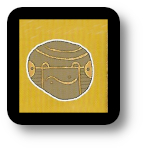
These buggers are hard to find
Solo?
The game box suggests that Pocket Dungeon Quest can be played with only one player. Sure, anything is possible, but no rules were provided for this type of game play. We didn’t think it would be too hard to figure out, however. We gave one person four Hero tiles and told them to go at it. As you would expect, the game plays the same. The only real difference is that the player now has more inventory management considerations.
House Rules
Players lose the game if they are not able to revive a fallen ally. If we interpreted the rules correctly, only one item in the game can do that and it’s randomly placed somewhere in the dungeon to be found. This frustrated our younger players to no end. To resolve, we collectively agreed that a “Potion” Item tile could be used to revive the dead (there are five “Potion” Item tiles in the game). Instead of reviving the dead to full health, however, it only gives them back one Heart tile. This gives the players a better chance of winning, and by better, I mean by maybe a few percentage points. It’s enough to keep the players happy long enough to possibly finish a game.
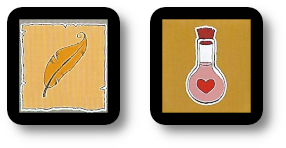
Use these to keep the game “alive”
To learn more about Pocket Dungeon Quest, visit the game’s web page.
Final Word
 The Child Geeks enjoyed themselves, finding the randomness of the game to be a mix of excitement and frustration. Combat is quick and brutal. Random dice rolls determine the result of a random encounter. This gave the Child Geeks a feeling of danger and adventure, which they all seemed to enjoy until their heroes died. According to one Child Geek, “The game can be tough. But if you are lucky, you and your friends can tackle the dungeon and save the day!” Emphasis here on luck. While the player’s do get to make some choices in the game, they are mostly reactionary and each turn is an exercise in painful hindsight. As one Child Geek put it, “You cannot learn much from this game other than patience.” Well said. As frustrating as some turns were, there were also moments of pure excitement and victorious outcomes. This was enough to offset any negativity the Child Geeks might have felt, resulting in the majority voting to approve Pocket Dungeon Quest.
The Child Geeks enjoyed themselves, finding the randomness of the game to be a mix of excitement and frustration. Combat is quick and brutal. Random dice rolls determine the result of a random encounter. This gave the Child Geeks a feeling of danger and adventure, which they all seemed to enjoy until their heroes died. According to one Child Geek, “The game can be tough. But if you are lucky, you and your friends can tackle the dungeon and save the day!” Emphasis here on luck. While the player’s do get to make some choices in the game, they are mostly reactionary and each turn is an exercise in painful hindsight. As one Child Geek put it, “You cannot learn much from this game other than patience.” Well said. As frustrating as some turns were, there were also moments of pure excitement and victorious outcomes. This was enough to offset any negativity the Child Geeks might have felt, resulting in the majority voting to approve Pocket Dungeon Quest.
 The Parent Geeks liked what the game was about, but found the game play to be frustrating. According to one Parent Geek, “I feel that all I’m doing is revealing tiles at random with what the game believes are meaningful choices, but really aren’t. I also think this is a game you can lose in the first round and be bored with until you exit, with most of the games being somewhere in the middle of the two extremes.” With their peers, the Parent Geeks found Pocket Dungeon Quest to be entertaining, but not all together engaging. With their kids, they found the game to be a fun shared adventure filled with pitfalls and shouts of victory. As one Parent Geek put it, “The game has a lot of potential with the family. It will create interesting gaming moments. For example, when my son and I were the only two heroes left. We knew we weren’t going to win the game, but we’d be damned if we didn’t take out the boss!” Yikes. When all the games were over, the Parent Geeks gave Pocket Dungeon Quest a mixed endorsement.
The Parent Geeks liked what the game was about, but found the game play to be frustrating. According to one Parent Geek, “I feel that all I’m doing is revealing tiles at random with what the game believes are meaningful choices, but really aren’t. I also think this is a game you can lose in the first round and be bored with until you exit, with most of the games being somewhere in the middle of the two extremes.” With their peers, the Parent Geeks found Pocket Dungeon Quest to be entertaining, but not all together engaging. With their kids, they found the game to be a fun shared adventure filled with pitfalls and shouts of victory. As one Parent Geek put it, “The game has a lot of potential with the family. It will create interesting gaming moments. For example, when my son and I were the only two heroes left. We knew we weren’t going to win the game, but we’d be damned if we didn’t take out the boss!” Yikes. When all the games were over, the Parent Geeks gave Pocket Dungeon Quest a mixed endorsement.
 The Gamer Geeks hated it. According to one Gamer Geek, “There is nothing to really think about in this game. You move, reveal, get your ass kicked, and move on. The only choices you do have to make are all inventory maintenance. I was bored.” Another Gamer Geek said, “This game is all about chance and I laughed my ass off when we all died after setting up the game for three minutes and then died in ten. This is not a game for those who want to sit down and engage in an activity that requires thinking.” The Gamer Geeks, if it’s not totally obvious at this point, voted to reject Pocket Dungeon Quest, preferring games that give players meaningful choices.
The Gamer Geeks hated it. According to one Gamer Geek, “There is nothing to really think about in this game. You move, reveal, get your ass kicked, and move on. The only choices you do have to make are all inventory maintenance. I was bored.” Another Gamer Geek said, “This game is all about chance and I laughed my ass off when we all died after setting up the game for three minutes and then died in ten. This is not a game for those who want to sit down and engage in an activity that requires thinking.” The Gamer Geeks, if it’s not totally obvious at this point, voted to reject Pocket Dungeon Quest, preferring games that give players meaningful choices.
 Pocket Dungeon Quest is not a game you engage with on a cerebral level. This game is more about coming together with friends and visiting while a game happens to be played in front of you. I’m not suggesting you can sleep walk through it, as the game does require cooperation and communication, but nor is it a game you need to really think about. You reveal the tiles, resolve them, and then pass the die. The only choices a player needs to make are, as one of the Gamer Geeks pointed out, focused on inventory control. Which is surprisingly important in hindsight. A player can only take so many tiles and each turns out to be a valuable resource. The only problem is, these valuable resources are not valuable all the time. For example, my Wizard carried with them the “Multi-tool” Item tile but did not once encounter a Trap tile.
Pocket Dungeon Quest is not a game you engage with on a cerebral level. This game is more about coming together with friends and visiting while a game happens to be played in front of you. I’m not suggesting you can sleep walk through it, as the game does require cooperation and communication, but nor is it a game you need to really think about. You reveal the tiles, resolve them, and then pass the die. The only choices a player needs to make are, as one of the Gamer Geeks pointed out, focused on inventory control. Which is surprisingly important in hindsight. A player can only take so many tiles and each turns out to be a valuable resource. The only problem is, these valuable resources are not valuable all the time. For example, my Wizard carried with them the “Multi-tool” Item tile but did not once encounter a Trap tile.
This is also a game that is impossible to get better at and very difficult to win. Because everything is random, players will need to search blindly for what is needed to be victorious. As they do so, they run the constant risk of being overwhelmed and poorly equipped to encounter what lives in the dungeon. Really, you get the feeling you are controlling one of the most unorganized and poorly planned dungeon raids in history.
Unless you are lucky.
If Lady Luck is on your side, Pocket Dungeon Quest makes you feel like a badass. Most of the time, however, you feel like your ass is being kicked to various degrees of intense bruising. This is not a game for those who are easily annoyed by random outcomes or dislike the lack of ability to improve and make meaningful choices for future games.
The game rules feel half-done. Players had lots of questions that were never addressed in the rule book. Simple things like, “Do I move the Merchant from the dungeon when I find him?” or “Do I need to be next to the Merchant to buy things?” There were also more substantial questions asked, such as “Do we all need to move to the dungeon exit when we find our relics or do we win when we have the relics and one of us finds the exit?” Little questions like this feel like big blockers when trying to learn the game. Luckily, these questions are easy to answer for yourself. Just fill in the gaps and you’re good to go. Pocket Dungeon Quest was not designed to be rules-heavy. It’s just too bad that some of the rules, as a result, are missing.
Everything in Pocket Dungeon Quest is up front, immediate, temporary, and superficial. How much fun you are going to have bumping into walls in the darkness and running headfirst into a pack of monsters is directly proportional to the amount of humor and tolerance you and your fellow players have for shenanigans. Give the game a try and see if this random adventure is right for you.
This game was given to Father Geek as a review copy. Father Geek was not paid, bribed, wined, dined, or threatened in vain hopes of influencing this review. Such is the statuesque and legendary integrity of Father Geek.



